Fermented onions are crisp and crunchy with a wonderfully mild flavor. Perfect for anyone who is typically sensitive to raw onions.
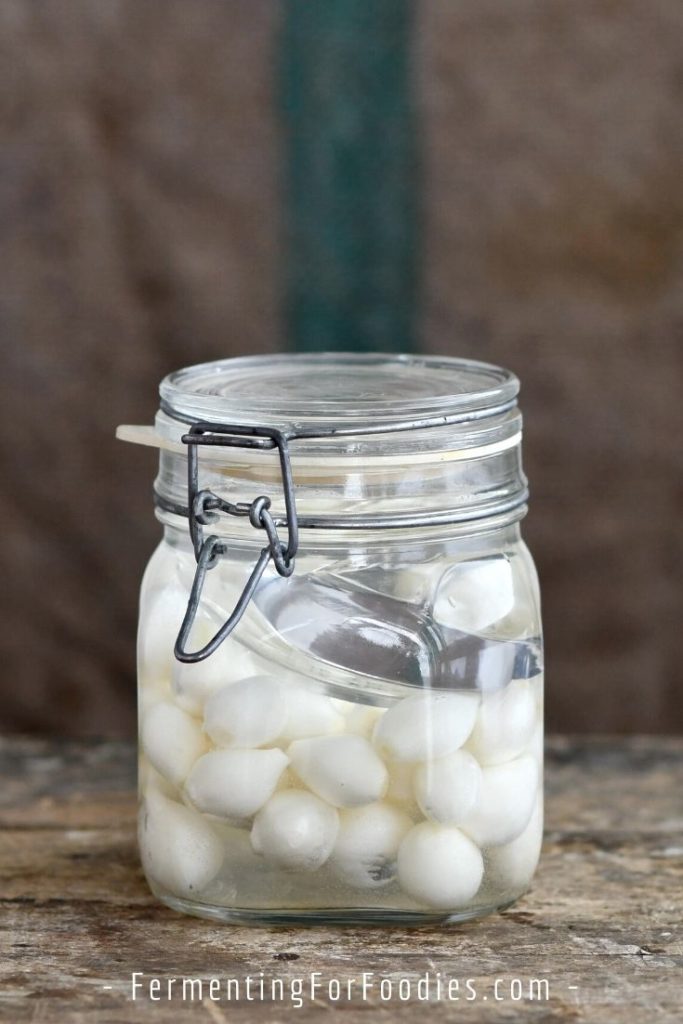
Lacto-fermented onions are very similar to vinegar-pickled onions in terms of flavor and texture. They are a bit less vinegary than pickled onions, but they are still deliciously tangy.
Fermenting is a great option for anyone who finds raw onion to be too strong. The mild flavor is easy to digest. They will last for several months in the fridge. I use them as a replacement for any recipe calling for raw onions.
Serving Fermented onions
My kids love snacking pickled vegetables and traditional dill pickles… onions aren’t really a snacking vegetable. However, they’re probably my FAVORITE fermented vegetable. That’s partly because I find raw onions hard to digest. They are also the most versatile vegetable ferment in my larder.
Don’t believe me? Here are just a few ways I serve fermented onions:
- Amazing in cheese sandwiches, particularly grilled cheese sandwiches.
- For salads, like Nicoise or cobb.
- In potato salad or deviled eggs
- Burgers or hot dogs
- Cheeseboard or charcuterie
- Tacos and nachos
- And the classic use is a Gibson’s martini
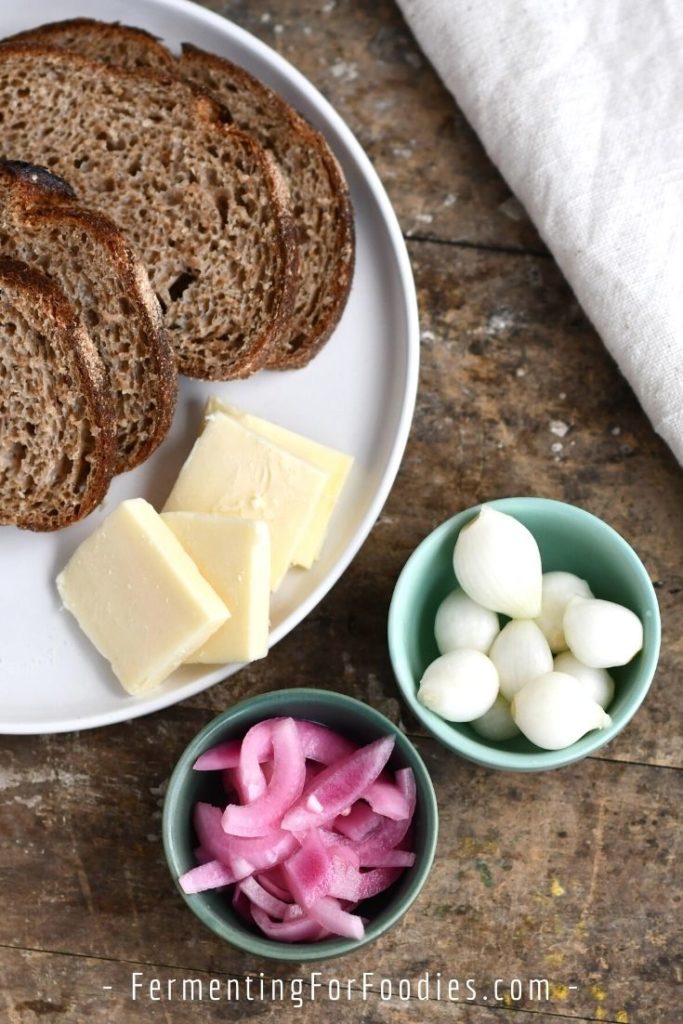
Using a starter culture
Onions don’t need a starter culture. However, it’s a great way to add flavor. Personally, I enjoy the added tanginess or sweetness that can come from a culture.
Feel free to use any probiotic or fermented culture. However, here are a few recommendations:
- For a bit of acidity use cultured apple cider vinegar or kombucha tea.
- Water kefir is perfect for adding sweetness.
- Whey from making strained yogurt or kefir cheese will soften the onions. However, it’s not my favorite culture because it can also make them a bit slimy.
- Vegetable starters are a good replacement for a wild-culture ferment. I recommend using one if you have issues with mold or poor indoor air quality. Otherwise, the salt-brine is all you need.
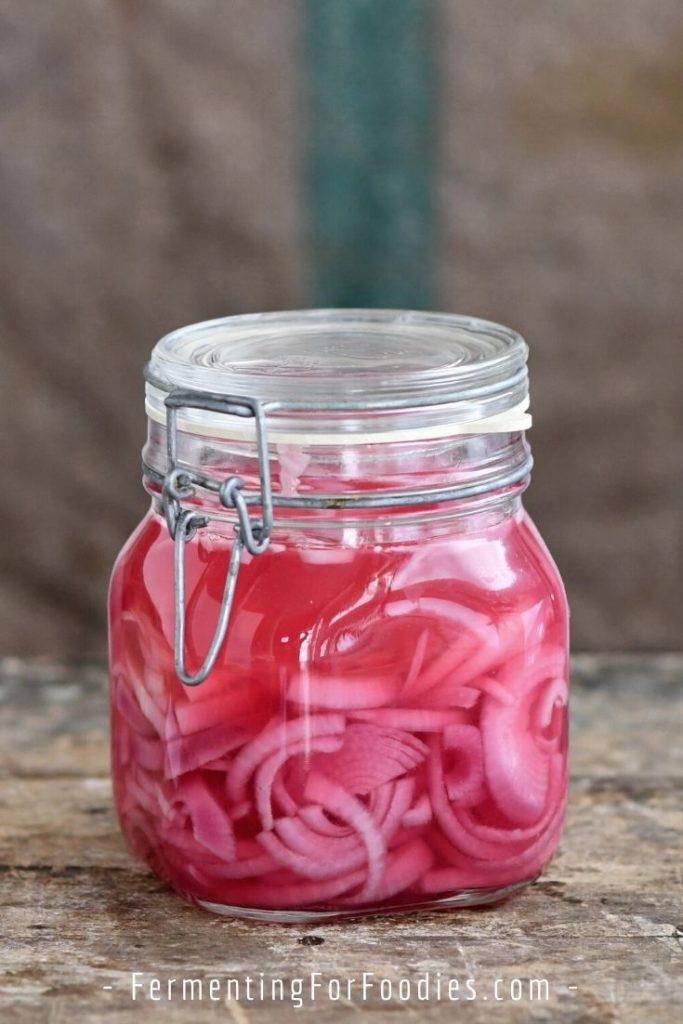
Fermented Onions
Fermented onions are crisp and crunchy pickled onions. The mild flavor is perfect for anyone sensitive to raw onions. They are delicious with grilled cheese or sliced into salads.
- Prep Time: 10 minutes
- Total Time: 10 minutes
- Yield: 1 quart jar 1x
- Category: Pickles
- Method: Fermented
- Cuisine: Probiotic
- Diet: Vegan
Ingredients
- 3 cups small cocktail onions or 2 large onions, sliced
- 1 Tbsp non-iodized salt
- 1 to 2 1/2 cups water (chlorine-free)
- 1/4 cup culture (optional – see section above for details)
Instructions
- Prepare the onions by slicing off the ends and peeling them. Pearl onions are easier to peel if they are submerged in cold water for about 10 minutes. Do not blanch them, as you don’t want to kill the natural bacterial culture on the onion. Large onions can be halved and sliced into thin rings.
- Mix the salt and 1 cup of water in a quart-sized (1 L) jar to make a brine. Mix in the culture, if you are using one. Onions don’t need a starter culture, however, it is a nice way to add flavor. See the section above for details.
- Add the onions to the jar and top with a weight. Onions float, so it’s important to use a weight to keep them submerged in the brine. Add enough additional water to fully submerge the onions. The exact amount required will depend on whether you’re using pearl onions or sliced onions, and if you’re using a starter.
- Cap with a loose-fitting lid or a fermentation-specific lid. Leave the onions somewhere dark to ferment for up to 1 week. They can be left in a dark location for up to a year, however, you need to take extra care to ensure a good ferment. See the notes for details.
- After fermenting, store in the fridge and use within 1-2 months.
Notes
- If you are sensitive to raw onions, make fermented slices rather than whole pearl onions, as they will be easier to digest.
- To ensure a good long ferment (more than one week), make sure to sanitize your jar. It’s also important to use a fermentation-specific jar that will allow gas to escape while preventing contamination. Personally, I like fido jars.
- It’s okay if you don’t have a good fitting fermentation weight. Just be sure to stir your onions every two days, so that all onions have a chance to be below the brine.

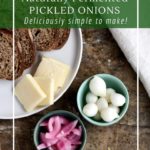
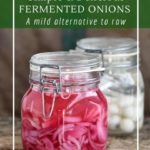

Another great, simple recipe! 🙂 I’ve heard before that pickling onions can be a tricky matter due to the brine salt concentration, but would love to give this a try. For a classic, crisp pickle, are there any onion varieties you’d recommend? I think trying some mixed red and white could be interesting.
Vegetables always get softer as they ferment, so for crisp onions use whole tiny onions. Or if you’re using sliced onions, then only ferment for 2 days. Enjoy!
Great recipe. I would suggest adding a wild grape leaf – the tannins help to keep the crunch.
Great advice! Thanks!